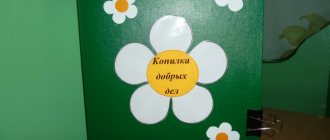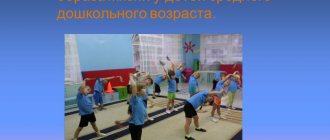Project “Proper nutrition is the key to health”
Authors:
Fedyunina Vera Vladimirovna, teacher
Ivanenko Elena Alekseevna, teacher
MA preschool educational institution Golyshmanovsky CRR-kindergarten No. 4 “Yolochka”
Project participants : pupils of the senior group “Solnyshko”, parents of pupils
Introduction
Rational nutrition is one of the environmental factors that determine the normal development of a child. It has a direct impact on the baby’s life activity, growth, and health.
Only proper, balanced nutrition that meets the physiological needs of a growing body increases resistance to various adverse effects. It is in preschool age that we must instill in children the concepts of “proper nutrition”, “healthy nutrition”, “healthy nutrition” in order to protect our children from frequently advertised chips, chocolates, hamburgers and soda.
Proper nutrition is the key to good health, performance, vigorous activity, excellent mood, the most important and indispensable condition for our health and longevity.
It ensures the normal physical development of the child, prevents the occurrence of such abnormalities as stunting, anemia, obesity, allergic manifestations, and digestive disorders.
Nutrition has a decisive influence on the development of the child’s central nervous system, his intellect, his state of performance, and contributes to the formation of an organism capable of overcoming the difficulties of life.
The problem is that children know little about the vitamins necessary for human health contained in vegetables and fruits, their beneficial properties, and do not eat enough natural vegetables and fruits, which they need to maintain and strengthen their health
Relevance: In childhood, the level of child health is largely determined by the quality of nutrition. A child's body differs from an adult in its rapid growth and intense metabolic processes. Eating wisely means not only ensuring that food contains proteins, fats, carbohydrates, vitamins, mineral salts and water in the required quantities, but also meeting the individual needs of children, taking into account the physiological characteristics and social conditions of life.
Project goal : developing healthy eating skills in preschool children.
Project objectives:
1. Formation of the basics of rational nutrition in preschoolers.
2. Introducing children to healthy products.
3. Formation of preschoolers’ ideas about the need to take care of their health.
4. Improving parents’ understanding of the importance and significance of proper nutrition for the child’s health and their own health.
5. Involving children and their parents in joint activities to study a healthy lifestyle, food hygiene, principles of food safety and quality.
6. Generalization and systematization of acquired knowledge about healthy eating.
Hypothesis: the implementation of the project will have a positive impact on the development of cognitive activity of children in our group, in terms of familiarizing them with the principles of healthy eating.
Project implementation stages
1. Preparatory
— selection of subject pictures and illustrations;
— selection of fiction (poems, stories, fairy tales, proverbs, sayings);
— work with methodological material, literature on this topic;
— notifying parents about an upcoming project;
— Questioning parents about proper nutrition.
2. Main
During the project implementation the following work was carried out:
Cognitive development
— Game situations: “Help put vegetables and fruits in different baskets”, “Guess what it is?”, “Salted or fresh?” (development of the sense of touch and taste buds);
— Conversations: “What vitamins are contained in vegetables and fruits”, “Healthy lifestyle”, “What can be prepared from vegetables and fruits”
— Conducting the “Guess the Taste” experiment;
— Didactic games: “Useful and harmful”, “The fourth odd one”, “Tops and roots”, “Which vegetable, guess?”.
Social and communicative development
— Didactic games: “Ascorbic acid and her friends” (introducing children to vitamins), “Find a home for vitamins” (distribute vitamins among vegetables and fruits),
“Riddles from the garden” (silhouette image of vegetables and fruits),
“Merry cooks” (cook borscht and compote),
“Wonderful bag” (guessing vegetables and fruits by touch,
“Recognize by taste”, “Recognize the dish”, puzzles “Vegetables and fruits”, “Match by color”, “Find a pair”
Speech development
— “What juice?”, “What jam?”, “What jam?” (Agreeing the endings of adjectives and nouns)
— “Call me affectionately” (use of diminutive suffixes)
“Our riddles” (composing descriptive riddles about vegetables and fruits)
— “One is many” (ending nouns)
— “Find by description” (development of coherent speech)
— “What grows where? (use of prepositions)
— Learning poems: Y. Tuvim “Vegetables”, learning proverbs, sayings, tongue twisters, counting rhymes, riddles
— Reading Literature: D. Rodari’s fairy tale “The Adventures of Chipolino”, Belarusian folk tale “Pykh”, S. Mikhalkov “Dispute of Vegetables”, “About the girl Yulia, who ate poorly”, V Suteev “Sack of Apples”, G. Sapgir “Riddles from the Garden” , S. Marshak “Signor Tomato”, V. Korkin “What grows in our garden?”, L. Zilberg "Useful product."
Artistic and aesthetic development
— Application “Preparations for the winter”
— Modeling “Vegetables in a plate”
— Plasticineography “Fruit Garden”
— Group work “Vitamins in vegetables and fruits”
— Coloring pages “Vegetables and fruits” - independent activity for children
Physical development
— Outdoor games: “Cucumber, cucumber”, “Gardener”, “Baba sowed peas”, “Tsar Peas”, “Vegetables and fruits”, “Tops and roots”, “Healthy - harmful” (similar to “Edible - not edible” ).
— Round dance games: “Zucchini”, “Harvest”, “Apple Tree”, “Let’s go through the raspberries to the garden”, “Hello, Autumn”.
— Finger gymnastics: “Orange”, “Vegetables”, “Cabbage”, “We are cooking, we are preparing compote”, “Our bed”, “We are standing in the garden”, “Apple”, “Lariska has two radishes”, “Fruits”, “The girl Arinochka has vegetables in her basket”, “Vegetable Garden”
3. Final
Final entertainment : theatrical performance of a musical fairy tale based on the cartoon “The Bremen Town Musicians”, “In a Certain State”.
Conclusion
So, the implementation of this project made it possible to expand and enrich children’s knowledge about proper nutrition and its benefits.
The children learned a lot about the vitamins contained in vegetables and fruits, gained practical skills in preparing some healthy dishes, and learned how to properly set the table;
They know how to distinguish between vegetables and fruits and choose the most useful ones. They know the importance of vitamins for the health of the body.
Joint project activities united educators, children and parents in common creative work and united the child-adult team.
As a result of working on the project, children became more interested in their health through healthy eating.
Our hypothesis was confirmed: the implementation of the project had a positive impact on the development of cognitive activity of the children in our group, in terms of familiarizing them with the principles of healthy eating.
List of used literature
1. Andreev Yu.A. New Three pillars of health - M.: Phoenix. 2014. - 350 p.
2. Gumenyuk E.I., Slisenko N.A. “Proper nutrition of preschool children.”-M, - 2011.
3. Konyaeva L. “Be healthy, baby” // Preschool education .- No. 11, 2004.
4. Makhoneva M. “Raising a healthy child” // Preschool education .-No. 6, 2002.
5. Soroka N.F. Nutrition and health. - Minsk, 2021. - 242 p.
6. Unzorg R. Encyclopedia of health. Healthy eating. - M.: "Christina and Co", 2012. - 234 p.
7. Internet resources.
“Certificate of publication in the media” Series A No. 0007681-0007682
We invite teachers of preschool education in the Tyumen region, Yamal-Nenets Autonomous Okrug and Khanty-Mansi Autonomous Okrug-Yugra to publish their teaching materials: - Pedagogical experience, original programs, teaching aids, presentations for classes, electronic games; — Personally developed notes and scenarios of educational activities, projects, master classes (including videos), forms of work with families and teachers.
Why is it profitable to publish with us?
1. “Kindergartens of the Tyumen Region” is an officially registered specialized media outlet at the federal level. 2. The activities of the editorial office are supported by the Department of Education and Science of the Tyumen Region 3. We issue a “Certificate of Publication” in the media. 4. The document has a unique number, is entered in the register, has the original seal of the editorial office of the online publication and signature. 5. “Certificate of publication” in the media is sent to the author in both paper and electronic versions.
Details >>>
Sample “Certificate of publication of author’s methodological material in the media.”pdf
Share
We follow the regime
For a child to eat well, food must be enjoyable
.
Cabbage and porridge cause no less joy than a piece of pie, if both are equally tasty and beautiful. Children love interestingly designed dishes made from a variety of products. In addition, it is very important to follow a dietary regime
.
If a child eats too rarely, at large intervals, his mental and physical abilities are reduced from hunger, and the desire to eat more can become a bad habit. If a child eats too often, his appetite worsens and he does not have time to get hungry. The optimal regimen
is considered to be four meals a day: breakfast, lunch, afternoon snack and dinner.
The calorie content of meals should be distributed as follows: 25 percent of the daily value is for breakfast, 40 percent for lunch, 15 percent for afternoon snack and 20 percent for dinner. A child attending kindergarten
most often eats there three out of four times. At home he only gets dinner. It makes sense for parents to take a copy of the weekly menu from the garden so as not to cook for dinner what the child has already eaten that day. It is also worth considering that not all foods need to be given to children every day. So, the list of products for every day includes milk, butter, bread, meat and fruits. But it is enough to get fish, eggs, sour cream and hard cheese once every two to three days.
Desires and security
Young children should prepare food in a way that is safe for them to eat. A baby can choke on a piece of meat, so it is better to cook it by first chopping it or grinding it into minced meat. Vegetables can be boiled and chopped, and prepared into casseroles, cutlets or pancakes. When cooking fish, you need to carefully select all the bones so that the baby does not choke. What to do if the child does not want
to eat certain foods?
First, try to find out why he doesn't want to eat them. Before offering food to your baby, try it yourself. Perhaps he just doesn't find it tasty. Change the recipe, add something else to the product, or, conversely, add it to some other dish. Do not force
your child to eat by persuasion, let alone threats - this can only achieve complete disgust.





